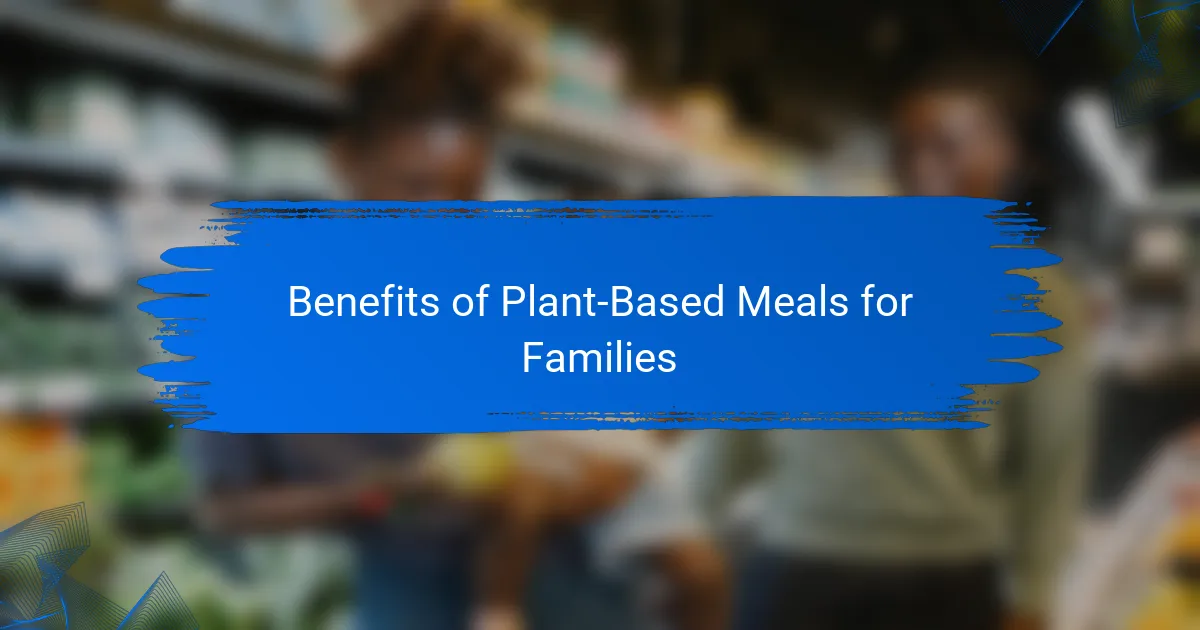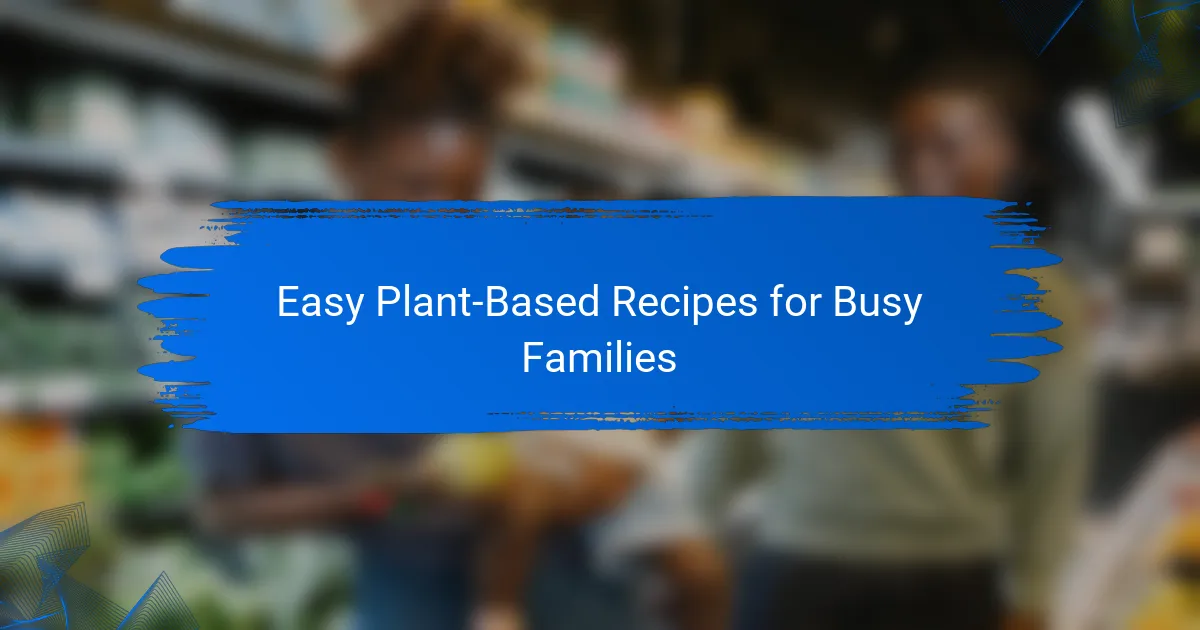Key takeaways
- Plant-based cooking emphasizes vibrant flavors and fresh ingredients, transforming meals into creative experiences.
- Involving the family in cooking and meal selection enhances bonding and makes plant-based eating enjoyable.
- Essential pantry items include legumes, whole grains, and seasonal produce, supporting nutritional and flavorful dishes.
- Gradual transitions to plant-based meals and the use of spices can make cooking exciting and accommodating for all family members.

Understanding Plant-Based Cooking
When I first started exploring plant-based cooking, I realized it’s not just about avoiding meat or dairy—it’s about discovering the vibrant flavors and textures of whole foods. Have you ever wondered how a simple bowl of roasted vegetables can taste so rich and satisfying? For me, it was a game-changer to focus on fresh ingredients and creative seasoning rather than missing out on what I thought I needed.
Understanding plant-based cooking means seeing it as an opportunity rather than a restriction. I’ve found that plants offer endless possibilities—from hearty lentil stews that feel like a warm hug on a cold Cleveland evening to crisp salads bursting with color and crunch. It’s this variety that kept me curious and eager to experiment in the kitchen.
What struck me most is how this way of cooking aligns with mindful eating and caring for my family’s health. Each plant-based meal became a small act of intention, and that connection made it more than just a diet choice. It felt like nurturing not only our bodies but also our time together around the dinner table.

Benefits of Plant-Based Meals for Families
Switching to plant-based meals brought a noticeable boost in energy for my whole family. I remember my kids actually asking for second helpings of the colorful veggie-packed dishes I prepared, which was a pleasant surprise. Isn’t it amazing how food packed with natural nutrients can fuel growing bodies without relying on heavy, processed options?
Another benefit I’ve seen is how plant-based eating naturally encourages us to explore seasonal, local produce, which helps support Cleveland’s farmers and markets. The freshness infuses each meal with vibrant flavors, and it’s fulfilling to know we’re eating with the environment in mind. Have you ever noticed how a garden-fresh tomato tastes completely different from one picked weeks ago?
Beyond nutrition and taste, plant-based meals have become a simple way for us to bond as a family. Cooking together, trying new recipes, and sharing stories over meals have made our dinner table a space of connection and creativity. It really shows how food can nurture relationships, not just bodies.

Essential Ingredients for Plant-Based Dishes
When I first stocked my kitchen for plant-based cooking, I quickly learned that a pantry full of legumes—like chickpeas, lentils, and black beans—is absolutely essential. These humble ingredients not only provide a hearty, protein-packed base but also bring incredible versatility to dishes, whether I’m whipping up a creamy hummus or a comforting chili on a chilly Cleveland night. Have you ever been amazed at how something so simple can transform a meal from ordinary to satisfying?
Another must-have for me has been a variety of whole grains like quinoa, brown rice, and farro. Their nutty flavors and chewy textures add depth and substance, turning meals into full experiences without needing any animal products. I remember the first time I swapped out white rice for farro in my family’s favorite stir-fry—it was a subtle change, but surprisingly elevated the dish and made me feel more connected to nourishing my family with intentional choices.
And of course, you can’t forget about fresh, seasonal produce—it’s the heart and soul of plant-based cooking. From crisp kale to ripe tomatoes and vibrant bell peppers, these ingredients burst with flavor and color that brighten any plate. I’ve found that shopping at our local Cleveland farmer’s market not only supports community farmers but also inspires me to create dishes that celebrate the season, making each meal feel like a fresh adventure.

Easy Plant-Based Recipes for Busy Families
Finding easy plant-based recipes that fit into a busy family’s hectic schedule was a challenge I quickly learned to overcome. One of my go-to tricks is prepping large batches of simple dishes—like a big pot of lentil soup or a colorful quinoa salad—that can be reheated or enjoyed cold throughout the week. It’s amazing how these recipes save time without sacrificing flavor, letting me focus on spending more quality moments with my family.
I also discovered that embracing quick, one-pan meals makes dinner prep less daunting. Stir-frying fresh veggies with tofu or beans, tossed in a homemade sauce, usually takes under 30 minutes and leaves minimal cleanup. Have you ever experienced that rewarding feeling when a wholesome meal comes together so effortlessly—giving you both nutrition and peace of mind at the end of a long day?
Snacks and kid-friendly options deserve their spotlight too. I often make energy bites using blended nuts, oats, and dates, or simple veggie wraps filled with hummus and crunchy greens. These easy-to-make treats not only keep hunger at bay but also introduce my children to plant-based flavors in a fun and approachable way. What parent wouldn’t love to hand over snacks that are both nutritious and loved by picky eaters?

Tips for Transitioning to Plant-Based Cooking
One tip that really helped me ease into plant-based cooking was starting small—introducing one or two meatless meals each week instead of overhauling my whole menu overnight. I found that this gradual approach took the pressure off and gave my family time to adjust without feeling deprived. Have you ever tried swapping your usual spaghetti Bolognese for a lentil and mushroom ragù? It surprised me just how satisfying that simple substitution could be.
Another insight I’ve gained is the power of spices and herbs. When I’m trying out a new plant-based recipe, I focus on bold flavors—like smoked paprika, cumin, or fresh basil—to keep dishes exciting and full of personality. It turns out that seasoning is what makes plant-based meals feel special rather than plain. If you’re wondering how to make roasted vegetables pop, trust me, a sprinkle of your favorite spice blend makes all the difference.
Lastly, don’t hesitate to involve your family in the journey. I started letting my kids pick out a new vegetable or fruit at the Cleveland market each week, which sparked their curiosity and enthusiasm. This shared experience made the transition feel like an adventure rather than a chore. When everyone has a hand in the kitchen, plant-based cooking becomes a collective joy, not just a solo effort. Wouldn’t you agree that food tastes better when it’s made and enjoyed together?

Overcoming Challenges in Plant-Based Cooking
Overcoming challenges in plant-based cooking wasn’t always easy for me, especially when I first faced the skepticism of picky eaters at the dinner table. Have you ever nervously watched as your family tries a new dish, unsure if they’ll like it? I learned that patience and persistence were key—offering familiar flavors with a plant-powered twist helped ease that transition.
Another hurdle was learning how to balance meals so they felt filling and nutritious without relying on meat or cheese. I remember experimenting with different combinations of beans, grains, and veggies until I found that perfect harmony that satisfied everyone. It felt empowering to know I could create meals that were both wholesome and hearty without compromise.
Sometimes, time constraints made me doubt whether I could keep up with plant-based cooking alongside my busy Cleveland family life. That’s when I discovered the magic of meal prep and simple staples that could be tossed together quickly. Finding those shortcuts didn’t just save time—it gave me peace of mind knowing my family was still getting nourishing food even on the busiest days. Have you found your own little hacks that make healthy cooking doable?
